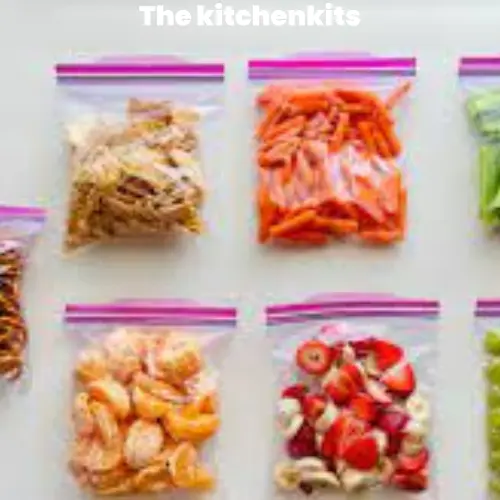Thekitchenkits.online is an Amazon Associate and earns from qualifying purchases made through affiliate links on our site at no extra cost to you. This supports our efforts to bring you valuable kitchen-related content.
Table of Contents
Are Ziploc Bags Microwave Safe?
Ziploc bags are generally considered microwave-safe, but it’s important to follow proper guidelines to ensure safe use. The risk of potential health hazards increases if the bags are not used correctly. Ziploc bags are made of polyethylene plastic, which is heat-resistant and designed to withstand high temperatures. However, if the bags are heated for too long, they can melt or release harmful chemicals into the food. It is recommended to use microwave-safe containers when possible, but if you choose to use Ziploc bags, follow the instructions on the packaging and do not overheat them. Additionally, it’s important to avoid using bags that are damaged or have small holes, as they may leak or break during use.
Ziploc bags are a convenient and popular way to store and transport food items. They are widely used in households and commercial settings alike. With the rise of microwave ovens, many people wonder if Ziploc bags are safe to use in the microwave. In this article, we will explore the safety concerns associated with microwaving Ziploc bags and how to use them safely.
Understanding Microwave Safety with Plastic Bags:
Microwaving food in plastic containers is a common practice in many households. However, not all plastic containers are safe for use in the microwave. When plastic is exposed to high temperatures, it can release harmful chemicals that can leach into your food. This can pose a serious health risk if consumed regularly. Therefore, it is essential to understand the microwave safety of plastic bags.
US FDA Requirements for Microwave-Safe Plastic Containers:
The US FDA has strict guidelines for the use of plastic containers in the microwave. According to their regulations, plastic containers must be labeled as “microwave-safe” to be used in the microwave. This means that the container has been tested and certified to be safe for use in the microwave. The FDA also recommends using containers that are labeled as “microwave-safe” for added safety.
Understanding What Are Ziploc Bags?
Ziploc bags are a type of plastic bag that is commonly used for food storage and transport. They are made from high-quality polyethylene plastic and come in various sizes and types. Some Ziploc bags have a slider closure, while others have a press-and-seal closure. They are a popular choice for storing food items in the freezer, refrigerator, and pantry.
Types and Sizes of Ziploc Bags:
Ziploc bags come in a variety of types and sizes to suit different needs. Some common types of Ziploc bags include sandwich bags, snack bags, quart bags, and gallon bags. Sandwich bags and snack bags are small and are used to store small food items, such as snacks and sandwiches. Quart bags and gallon bags are larger and are used to store larger food items, such as fruits and vegetables.
The Risks of Microwaving Food in Plastic Containers
Microwaving food in plastic containers can be dangerous if not done correctly. When plastic is exposed to high temperatures, it can release harmful chemicals that can leach into your food. This can pose a serious health risk if consumed regularly. Some of the chemicals that can be released from plastic containers include BPA, phthalates, and lead.
How to Use Ziploc Bags Safely in the Microwave
To use Ziploc bags safely in the microwave, follow these tips:
1. Use only Ziploc bags that are labeled as “microwave-safe.
2. Do not reuse Ziploc bags that were previously used to store non-food items, such as chemicals or makeup.
3.Do not overfill Ziploc bags, as this can cause them to burst in the microwave.
4. Open the Ziploc bag slightly to allow steam to escape during microwaving.
Do not microwave Ziploc bags that have plastic sliders or press-and-seal closures.
Precautions to Take When Using Ziploc Bags in the Microwave
When using Ziploc bags in the microwave, it is essential to take precautions to ensure safety. Some precautions to take include
Precautions for Microwaving food:
Following are the precautions you must follow for when microwaving food:
- Use microwave-safe cookware to cook food whenever possible.
- Avoid using plastic containers that are cracked or damaged.
- Do not use plastic wrap or plastic bags that are not labeled as microwave-safe.
- Do not microwave food in containers that are too small, as this can cause them to overheat and release harmful chemicals.
- Always follow the instructions provided by the manufacturer for using the Ziploc bag in the microwave.
Can You Cook Food in Ziploc Bags?
Yes, you can cook food in Ziploc bags using a method called sous vide cooking. Sous vide cooking involves sealing food in an airtight bag and cooking it in a water bath at a precise temperature. It’s important to use bags that are made specifically for sous vide cooking and is BPA-free, such as Ziploc freezer bags.
Sous Vide Cooking with Ziploc Bags
Sous vide cooking with Ziploc bags is a popular method for home cooks. To use Ziploc bags for sous vide cooking, fill the bag with food and seal it, removing as much air as possible. Then, place the bag in a water bath at the desired temperature and cook for the recommended time.
Can You Reuse Ziploc Bags?
Ziploc bags can be reused, but it’s important to wash them thoroughly after each use. Bags that have been used to store raw meat should not be reused. Additionally, Ziploc bags that have been used for sous vide cooking should not be reused if they have been exposed to temperatures above 158°F (70°C).
Washing Ziploc Bags the Right Way
To wash Ziploc bags, rinse them with warm water and soap, then turn them inside out and wash them again. Hang the bags to dry, or place them over a drying rack. Avoid using harsh chemicals or abrasive sponges, as this can damage the bags.
Alternatives to Ziploc Bags for Microwave Cooking
If you’re looking for alternatives to Ziploc bags for microwave cooking, consider using microwave-safe glass containers or silicone bags. These alternatives are reusable and can be washed easily.
Common Misconceptions About Using Ziploc Bags in the Microwave
One common misconception about using Ziploc bags in the microwave is that they can release harmful chemicals. However, Ziploc bags are made from materials that are safe for microwave use. Another misconception is that Ziploc bags can’t be reused, but as mentioned earlier, they can be reused if washed properly.
FAQs
Are there any alternatives to using Ziploc bags for microwave cooking?
Yes, there are several alternatives to using Ziploc bags for microwave cooking, such as glass or ceramic dishes, microwave-safe plastic containers, or silicone bags. These alternatives are typically more durable and can be used repeatedly, making them a more environmentally friendly option.
How do I know if a Ziploc bag is microwave safe?
Look for the microwave-safe symbol on the packaging or check the product label. If the label doesn’t mention microwave safety, assume the bag is not microwave safe.
What happens if you microwave a Ziploc bag for too long?
If Ziploc bags are heated for too long, they can melt or release harmful chemicals into the food. To avoid this, follow the instructions on the packaging and do not overheat the bags
Conclusion:
In conclusion, Ziploc bags can be safely used in the microwave as long as you follow proper guidelines. It’s important to only use bags that are labeled as microwave safe, avoid overheating, and never cook foods that can produce steam or contain oil or fat. Additionally, take precautions to ensure that the bags are not damaged or have small holes. While there are alternative options available for microwave cooking,
Ziploc bags remain a convenient and affordable choice for many people. By using them safely and responsibly, you can enjoy the convenience of cooking and reheating food in the microwave while minimizing potential health hazards.

I’m Ian Welkins, a seasoned professional in the kitchen industry. My passion now drives me to provide invaluable insights into the world of top-notch kitchen products. With years of hands-on experience, I’m your go-to source for culinary excellence.


